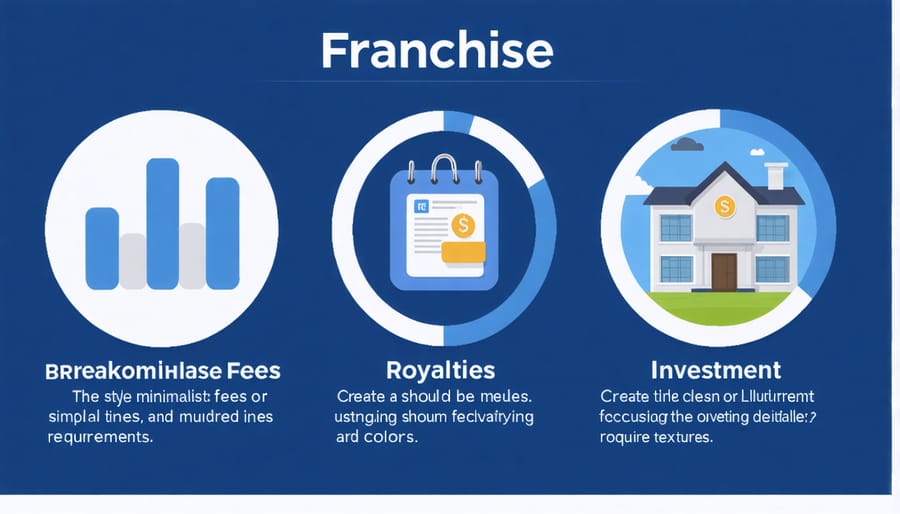
Transform your thriving business into a successful restaurant franchise with a strategic approach that maximizes your growth potential. Franchising offers an exciting path to expansion, allowing you to share your proven business model while building a network of dedicated entrepreneurs who believe in your vision.
Before diving into the nine essential steps, consider this: successful franchises aren’t just about great products or services – they’re about creating systems that others can replicate with confidence. Whether you’re running a beloved local café or a innovative retail concept, your journey to becoming a franchisor starts with understanding the transformation ahead.
Think of franchising as sharing your business’s DNA. You’ve already created something special; now it’s time to package that magic into a format that ambitious entrepreneurs can unwrap and bring to life in their own communities. From legal requirements to training programs, each step in this guide will help you build a franchise system that maintains your brand’s integrity while creating opportunities for others to succeed.
Ready to turn your business into the next big franchise? Let’s explore the nine crucial steps that will take you from local success story to expanding franchise empire.
Evaluating Your Restaurant’s Franchise Potential
Brand Recognition and Market Success
Before diving into the exciting world of franchising, it’s crucial to take an honest look at your brand’s current standing in the marketplace. I’ve learned from working with countless entrepreneurs that having a proven franchising strategy starts with understanding your unique position in the market.
Think of your brand recognition as your business’s superpower. Are customers already familiar with your name? Do they actively seek out your products or services? Look for indicators like steady foot traffic, positive online reviews, and strong social media engagement. These are golden signs that your brand resonates with your target audience.
Consider your competitive advantage – what makes your business special? Maybe it’s your grandmother’s secret recipe, your innovative service approach, or your Instagram-worthy store design. This uniqueness will be crucial for attracting potential franchisees.
Remember, successful franchising isn’t just about current success; it’s about scalability. Take some time to gather customer feedback, analyze your sales trends, and identify what aspects of your business model consistently drive results. This information will be invaluable as you move forward with your franchising journey.
Systems and Operations Analysis
Before you can package your business into a franchise model, you’ll need to take a deep dive into how everything currently operates. I remember when my friend Sarah franchised her boutique fitness studio – she spent weeks documenting every little detail, from how she greeted clients to how she organized class schedules.
Start by mapping out all your daily operations, from opening procedures to closing routines. Think about which processes make your business unique and successful. Are your special recipes documented? Is your customer service approach clearly defined? These elements need to be easily replicable by future franchisees.
Next, evaluate your systems for scalability. Your point-of-sale system, inventory management, and training programs should be able to handle multiple locations. Consider whether your suppliers can accommodate increased orders and if your operational procedures would work across different locations and markets.
Create detailed manuals for everything – and I mean everything! From employee handbooks to marketing guidelines, these documents will become your franchise bible. Remember, your goal is to create a business model that others can follow successfully while maintaining your brand’s special touch.

Legal Framework and Documentation
Franchise Disclosure Document (FDD)
Let me break this down in a way that won’t make your head spin! The Franchise Disclosure Document (FDD) is like the ultimate playbook for your franchise journey – it’s a legal requirement that protects both you and your future franchisees. Think of it as sharing your secret recipe, but with all the important business details included!
Your FDD needs to include 23 specific items, from your business background story to financial statements. I remember when I first tackled my FDD – it felt overwhelming until I broke it down into manageable pieces. You’ll need to detail your franchise fees, estimated initial investment, and any restrictions you’re placing on your franchisees.
Some key elements you’ll want to focus on include your business history, litigation history (don’t worry if you don’t have any!), and financial statements from the past three years. You’ll also need to outline your training programs, territory rights, and any proprietary information you’ll be sharing.
Here’s a pro tip: While you can find FDD templates online, I strongly recommend working with a franchise attorney to create this document. They’ll ensure you’re not just checking boxes but truly protecting your business interests while being transparent with potential franchisees.
Remember, your FDD isn’t just paperwork – it’s the foundation of trust between you and your future franchise family. Take the time to make it comprehensive and clear!
Trademark and Intellectual Property Protection
Think of your brand as your business’s signature – it’s unique, valuable, and worth protecting! As someone who’s helped countless entrepreneurs navigate this journey, I can’t stress enough how crucial it is to secure your intellectual property before franchising.
Start by registering your trademark with the United States Patent and Trademark Office (USPTO). This includes your business name, logo, and any distinctive phrases or designs that make your brand special. Remember that cute catchphrase your customers love? That needs protection too!
Next, document all your trade secrets – those special recipes, unique processes, or innovative methods that give your business its competitive edge. Create comprehensive confidentiality agreements and make them a non-negotiable part of your franchise agreements. I’ve seen too many business owners learn this lesson the hard way!
Consider working with an intellectual property attorney who specializes in franchising. They’ll help ensure your franchise disclosure document (FDD) includes robust intellectual property protection clauses. They can also guide you through international trademark registration if you’re dreaming of taking your franchise global (and why not dream big?).
Don’t forget about your digital assets! Register relevant domain names, secure your social media handles, and protect your website content. In today’s digital world, your online presence is just as valuable as your physical one.
Remember, protecting your intellectual property isn’t just about legal defense – it’s about preserving the unique essence that makes your business special and franchisable.
Creating Your Franchise Operations Manual
Standard Operating Procedures
Think of your business operations as your secret recipe for success – every detail needs to be documented crystal clear! When I started helping business owners with franchise restaurant operations, I learned that having thorough SOPs is absolutely non-negotiable.
Start by documenting every single process in your business, from opening procedures to customer service protocols. Create detailed manuals that cover daily operations, employee training, quality control, and crisis management. Remember, your future franchisees will rely on these documents to replicate your success!
Let me share a pro tip: Use video tutorials alongside written procedures – they’re game-changers for visual learners. Break down complex tasks into simple, easy-to-follow steps. Include checklists, troubleshooting guides, and clear metrics for success.
Don’t forget to document your brand standards too! Everything from your logo usage to your social media voice should be spelled out. The goal is to make your business system so clear that anyone could step in and run it exactly as you would.
Test your procedures with current employees and refine them based on feedback. What seems obvious to you might need more explanation for others. Remember, these SOPs will be your franchise’s backbone!

Quality Control Standards
Think of quality control standards as your secret recipe for success across all franchise locations. Just like how your favorite coffee chain serves the same delicious latte whether you’re in New York or California, your franchise needs that same level of consistency to thrive.
Start by documenting every aspect of your business operations in detail. I learned this lesson when visiting a friend’s franchise locations – the one that followed the guidelines precisely was thriving, while another that took “creative liberties” struggled with customer satisfaction. Create clear, step-by-step manuals for everything from product preparation to customer service protocols.
Implement a robust training program that ensures every franchisee and their staff understand and can execute these standards flawlessly. Consider establishing a quality assurance team to conduct regular inspections and provide support where needed. Remember to include specific metrics for evaluation, such as customer satisfaction scores, product quality checks, and service timing standards.
Don’t forget to build in some flexibility for local market adaptations while maintaining your core brand standards. The key is finding that sweet spot between consistent quality and allowing franchisees to connect with their local community. Regular feedback sessions with franchisees can help you refine these standards while keeping everyone aligned with your brand vision.
Financial Planning and Structure

Fee Structure and Royalties
Let’s talk about the money side of franchising – it’s like setting up the perfect recipe for success! When determining your fee structure, you’ll typically want to establish three main components: an initial franchise fee, ongoing royalty payments, and potentially a marketing or advertising fee.
The initial franchise fee usually ranges from $20,000 to $50,000, depending on your brand’s value and support package. Think of it as an entry ticket that covers your initial training, support, and the right to use your brand. I remember chatting with Sarah, a successful franchise owner, who shared how she structured her fees to be competitive while ensuring she could provide top-notch support to her franchisees.
For ongoing royalties, most franchisors charge between 4% to 8% of gross sales. This steady income stream helps you maintain quality control and provide continuous support. Consider setting up a marketing fee (typically 1-3% of sales) to build a collective advertising fund that benefits all locations.
Pro tip: Make sure your fee structure aligns with your target franchisee’s financial capabilities while providing enough revenue to sustain your support system. Remember, transparency about fees builds trust with potential franchisees!
Investment Requirements
When I started exploring franchising, one of the first questions I asked was about money – and I bet you’re wondering the same thing! Understanding franchise investment requirements is crucial for both you and your potential franchisees.
Start by calculating the total initial investment needed, including franchise fees, equipment, inventory, real estate costs, and working capital. I recommend creating a detailed financial model that outlines both one-time costs and ongoing expenses. For most franchises, you’ll want franchisees to have at least 30% of the total investment in liquid capital.
Remember to be transparent about additional costs like royalty fees, marketing contributions, and technology fees. In my experience, providing a clear financial picture helps attract serious, qualified candidates. Consider offering different investment tiers if possible – some of my most successful franchisees started with smaller locations before expanding.
Pro tip: Work with a financial advisor to set realistic requirements that ensure franchisee success while maintaining your brand standards. The goal is to make your franchise accessible enough to attract quality partners while ensuring they have sufficient resources to succeed.
Training Program Development
Training your franchisees effectively can make or break your franchise’s success. I learned this firsthand when helping my sister launch her successful bakery franchise – the key was creating a training program that felt less like a boring manual and more like a supportive mentorship journey.
Start by documenting every aspect of your business operations, from daily procedures to your secret recipes and customer service protocols. Think about what made your business successful and break it down into teachable modules. Consider incorporating modern training solutions like video tutorials, interactive modules, and hands-on workshops to accommodate different learning styles.
Your training program should include:
– Initial classroom-style orientation
– Hands-on operational training
– Management and leadership development
– Marketing and sales techniques
– Customer service standards
– Financial management basics
– Quality control procedures
– Crisis management protocols
Remember to create supporting materials like operations manuals, quick reference guides, and digital resources that franchisees can refer to after training. The goal is to make your franchisees feel confident and equipped to replicate your success story.
Don’t forget to build in ongoing support mechanisms – monthly check-ins, refresher courses, and a mentorship program can help franchisees stay aligned with your brand standards while growing their confidence. Consider creating an online community where franchisees can share experiences and learn from each other.
The best training programs evolve based on feedback, so establish a system to gather input from your franchisees and adjust your program accordingly. This collaborative approach helps create a stronger franchise network while maintaining consistent quality across all locations.

Marketing and Franchise Sales Strategy
Marketing your franchise opportunity is like telling your business’s love story – you want to attract the right partners who share your vision and values. Start by creating a compelling franchise marketing plan that showcases what makes your business special. I’ve found that authentic storytelling about your journey and success can really resonate with potential franchisees.
Begin with a clear ideal franchisee profile. Think about the qualities, experience, and financial capabilities you’re looking for. Remember when I first started screening franchisee applications, I learned that passion and cultural fit are just as important as financial qualifications.
Develop professional marketing materials that speak to your target franchisees. This includes a detailed franchise disclosure document (FDD), engaging franchise brochures, and a dedicated franchise section on your website. Share success stories from your business journey and highlight what makes your franchise opportunity unique.
Consider multiple channels to reach potential franchisees: franchise websites, trade shows, social media, and business networking events. In my experience, franchise expos are fantastic for making personal connections and answering questions face-to-face.
Create a structured process for evaluating and selecting franchisees. This might include initial applications, interviews, discovery days, and thorough background checks. Remember to trust your instincts – I once passed on a financially qualified candidate because their values didn’t align with our brand’s mission.
Don’t forget to leverage your existing network! Some of your best franchisees might come from referrals from current employees, suppliers, or business associates. Building a strong franchise community starts with choosing the right partners who will represent your brand with the same passion and dedication you do.
Support System Implementation
Picture this: You’ve launched your first franchise location, and your franchisee calls with an urgent question about the point-of-sale system. Having a robust support system in place means they’ll never feel left in the dark during these crucial moments.
Creating a comprehensive support structure is like building a safety net for your franchise family. Start by developing a detailed operations manual that covers everything from daily procedures to troubleshooting common issues. I remember when a fellow business owner shared how her lack of documentation led to consistency problems across locations – let’s learn from that!
Set up a dedicated support team that’s easily accessible through multiple channels. This might include a help desk, regular check-in calls, and an online portal where franchisees can access resources 24/7. Consider implementing a mentorship program where experienced franchisees can guide newer ones, fostering a sense of community and shared success.
Regular training sessions are essential, both initial and ongoing. Schedule quarterly workshops, webinars, or in-person meetings to address common challenges and share best practices. Make sure to create a feedback loop where franchisees can voice their concerns and suggestions – some of our best system improvements have come from franchisee input!
Don’t forget about marketing support. Provide your franchisees with pre-approved materials, campaign templates, and social media guidelines. Consider setting up a marketing fund where all franchisees contribute to larger-scale promotional efforts that benefit the entire network.
Remember, your support system should evolve as your franchise grows. Stay flexible and ready to adapt based on your franchisees’ changing needs and market conditions.
Pilot Program Launch
Before rolling out your franchise model to the masses, it’s essential to test the waters with a pilot program. Think of it as a dress rehearsal for your big franchise debut! I remember chatting with Sarah, a successful bakery owner, who shared how her pilot program helped her avoid potential pitfalls and refine her franchise model.
Start by selecting 2-3 locations for your pilot program. These should be in different markets to help you understand how your business model performs in various settings. Ideally, choose locations that represent different demographics and market conditions you might encounter during wider expansion.
During this phase, document everything meticulously. Track what works, what doesn’t, and where adjustments are needed. Pay special attention to your operations manual in action – are the procedures clear enough for others to follow? Is your training program effective? How well does your support system function?
The pilot program typically runs for 6-12 months, giving you enough time to gather meaningful data and make necessary tweaks. Use this period to fine-tune your franchise fees, royalty structures, and territory definitions. Most importantly, maintain open communication with your pilot franchisees. Their feedback is pure gold!
Remember, it’s better to discover and address challenges during this controlled testing phase than after you’ve sold dozens of franchises. Consider your pilot program an investment in your franchise’s future success.



